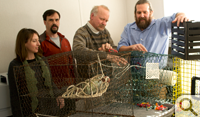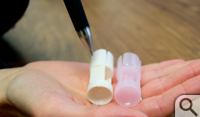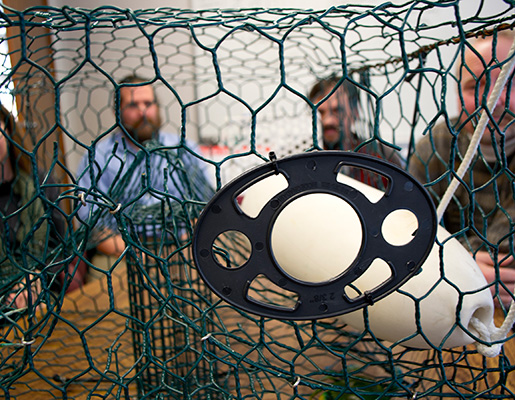PHAs: Bacteria make them. Bacteria eat them. Now we can use them to help save the Chesapeake
PHAs are plastics that are made by bacteria. PHAs also are eaten by bacteria.
“It’s like fat,” Kirk Havens says. He explained that just as vertebrates store energy in fat deposits, many bacteria synthesize PHAs—short for polyhydroxalkanoates—to store carbon and energy. An individual bacterium will draw on its little dab of polymer reserve to get through the lean days in its microscopic world, unless a bigger microorganism eats it first. Anything made of PHA will biodegrade, simply because bacteria start eating it.
Havens is one of a group of VIMS researchers working with Jason McDevitt, William & Mary’s director of technology transfer, to bring products based on these biopolymers to market. The products are aimed at an environmentally conscious market that ranges from commercial fishermen to recreational hunters to the millions of people using a wide range of personal care products.
 The researchers are all members of the VIMS Center for Coastal Resources Management. The group includes Havens, assistant director of the center; Kory Angstadt, marine scientist; Donna Bilkovic, research associate professor; and David Stanhope, field research manager. Their interest in PHAs began with the accidental discovery of the abundance of “ghost pots” in the Chesapeake Bay.
The researchers are all members of the VIMS Center for Coastal Resources Management. The group includes Havens, assistant director of the center; Kory Angstadt, marine scientist; Donna Bilkovic, research associate professor; and David Stanhope, field research manager. Their interest in PHAs began with the accidental discovery of the abundance of “ghost pots” in the Chesapeake Bay.
Bilkovic, Stanhope and Angstadt were using side-scan sonar to distinguish various habitats such as sea grasses and oyster or mussel beds. These various habitats are important to fishes and the work was part of a project to map the shallow-water bottoms of the Chesapeake Bay. The sonar was showing up a surprising number of square objects. The square things turned out to be crab traps that had lost their buoys and were now unattended.
A round-up of lost traps showed a number of things, all of which were disturbing. The first bit of bad news was the sheer number of pots, Havens said. The second was their durability: He said many of the traps were encrusted, but in good condition. The third, and most disturbing revelation, is that the ghost pots “self bait” in something like perpetuity. An animal goes in the trap, dies, then becomes bait for the next victim.
A census of a sampling of the Chesapeake ghost pot catch showed the Center for Coastal Resources Management scientists that lost fishing traps place a heavy toll on sea life. The group began investigating the properties of PHA in a quest for a way to disarm lost traps by incorporating an “escape panel.” The VIMS group examined a number of materials and methods before settling on a PHA panel.
“Other escape panels use degradable or biodegradable attachment points,” Bilkovic explained. “We have found that it just takes a little bit of encrustation from a single barnacle to prevent that from working. The nice thing about PHA is that the material completely disappears over time.”
Their first panel, designed for the blue-crab trade, was made to erode gradually in the water over a period of eight to ten months. The panel is designed to take the place of a circular cull ring, required by the state, whose purpose is to let undersized blue crabs escape the trap. Angstad held up the latest model, an oval piece of plastic that seems indistinguishable from a conventional plastic.
“See how nice they are at the beginning?” he asked, scraping a thumbnail across the surface. “Our idea is for it to last a season for a waterman, so they don’t have to constantly replace them. But we can make them last a longer or shorter time by making them thicker or thinner.”
After a round of testing by watermen, the VIMS team began looking at panels for other types of fish traps. A variety of slowly dissolving escape-panel prototypes sit in an aquarium at the Center for Coastal Resources Management; a stationary camera records the daily progress of their destruction. Another corner is stacked high with stone crab traps, eel traps, Dungeness crab traps, lobster pots, crawdad traps and other specialized assemblies of mesh and wire used to harvest finfish and crustaceans in fresh and saltwater around the world. Ghost pots, the researchers say, are a problem everywhere.
As much as a problem as ghost pots are, they represent just one segment of an enormous set of environmental issues caused by marine debris. Their work with PHA escape panels brought the Coastal Resources scientists in touch with other people interested in remediating marine debris problems.
“It made us more conscious of the issues of marine debris and of the issues of plastics in the marine and aquatic environments,” Havens said. “One of the issues that was beginning to emerge was microplastics and plastic pollution.”
Nondegradable plastic microbeads have become a significant component in many personal care products including facia
“The problem with microbeads is the size. They can be consumed by the base of the food web,” Havens explained. “If they’re consuming the non-biodegradable plastic, they’re not getting any nutrition from it. It’s a starvation issue. That’s one problem.”l exfoliants, toothpaste and cosmetics. These teeny spheres of (usually) polyethylene go down the drain and right through the water treatment plant into the environment. The beads contribute to the mass of virtually indestructible plastic invading waterways, but bring about a more immediate danger.
Bilkovic pointed out another issue with microbeads. She explained that some filter feeders such as tubeworms and barnacles are not particularly discriminating about what they take in and may not be equipped to reject items as unfamiliar and unnatural as polyethylene pellets.

The VIMS collaborators looked farther up the food web and saw another plastic component causing trouble in the water. Plastic shotgun wads have been accumulating in wetlands and on beaches. Waterfowl hunters shoot over streams and marshes and the wads—plastic components of shotgun ammunition—fall into the water. Wildlife often mistake the bobbing wads for prey items. Plastic wads have been found in the stomach of ocean-foraging birds.
“The birds seem to think it’s a squid or something like that,” Angstadt said.
McDevitt’s job is to help William & Mary faculty maximize the commercial potential of their work. He noted that the same environmentally safe properties that make PHA an ideal choice for dissolving crab trap panels make it an excellent material to substitute for plastics used in environmentally sensitive situations.
Commercial PHAs are even produced naturally, or at least in an industrialized version of the natural process. Producers of the biopolymers just set up vats of the appropriate bacteria.
“The nice thing about PHA is that it's biodegradable in aquatic systems, both marine and freshwater,” McDevitt said. ”It's been certified as biodegradable according to ASTM standards and it's been certified by the army.”
McDevitt has been in the pursuit of licensing and intellectual property rights to all three products. The escape panels are the most advanced PHA product, licensed to Mobjack Binnacle Products, a company co-founded by Mason School of Business alumnus Wade Blackwood. Mobjack markets a number of biodegradable escape panels for watermen who want to make lost fishing traps less dangerous to sea life. The Mobjack website offers the Big Blue biopanel for blue-crab traps, as well as the Stoney, for stone crabbers and the Langosta, for lobstermen.
Patents are pending on the PHA microbeads as well as the biodegradable shotgun wads, McDevitt said, but he noted that both products face product development and marketing challenges.
“The wads are earlier than the other two as far as prototype development and there's still a ways to go,” he said. “The manufacturing on the wads is a little tricky as well. If you look at a shotgun wad, it’s manufactured by injection molding so that's a little tougher for us to bang out prototypes.”
Success of the various PHA products could be expedited by regulations or legislation. Havens points out that many states are looking at banning of microbeads. A measure in Virginia was introduced in 2014, but it didn’t get out of committee, he said.
“We’d love to see some well-balanced legislation that prohibits the use of microbeads that don't biodegrade in the water, but also allows use of microbeads that do biodegrade,” McDevitt said.
Even in the absence of legislation, many consumer products companies have already pledged to stop using plastic microbeads, and McDevitt believes it is likely that many consumers would be willing to pay a small premium for an environmentally friendly product.
He said that legislation requiring PHA escape panels would have the beneficial effect of leveling the playing field for watermen. McDevitt pointed out that while a consumer won’t miss a couple extra pennies for a PHA exfoliant, switching to biodegradable panels is a substantial expense for a commercial fisherman with several hundred fishing traps.
“It would be financially beneficial if everyone made the switch, as there would be more crabs to catch because lost traps would no longer deplete fisheries by continuing to catch crabs,” McDevitt said. “However, for the first adopter, it just puts them at a competitive disadvantage.”
He suggested that a well-reasoned set of regulations would eliminate the competitive disadvantage. Regulations might take the form of a blanket requirement to use a PHA panel or another product that genuinely prevents ghost fishing, but also could take the form of an incentive such as a slightly longer fishing season for watermen that use such devices.
McDevitt points out that once the microbeads and the shotgun wads are fully developed, the group may find itself marketing products to customers of Whole Foods and devotees of Duck Dynasty at the same time. It’s a strange position for the scientists, who say they never dreamed they would be involved in the plastics business when they started discussing the answer to the ghost pot problem.
“We just wanted to provide some solutions for saving sea life,” Havens said. ![]()
















